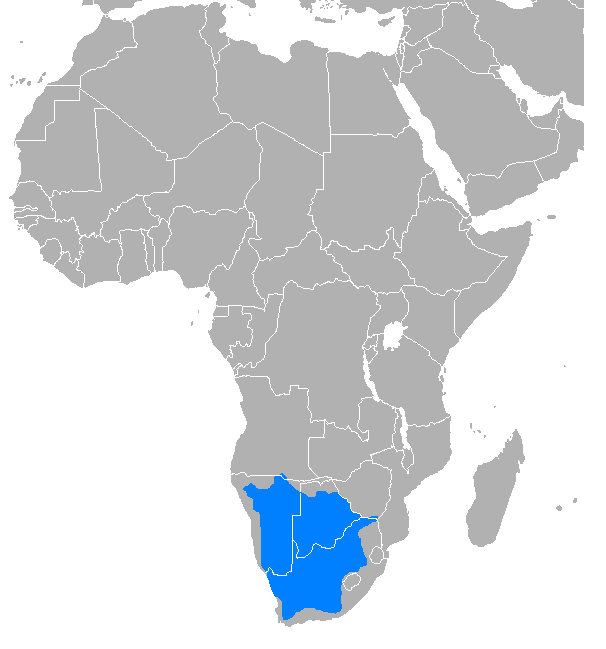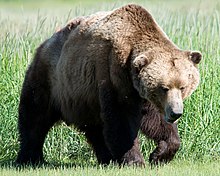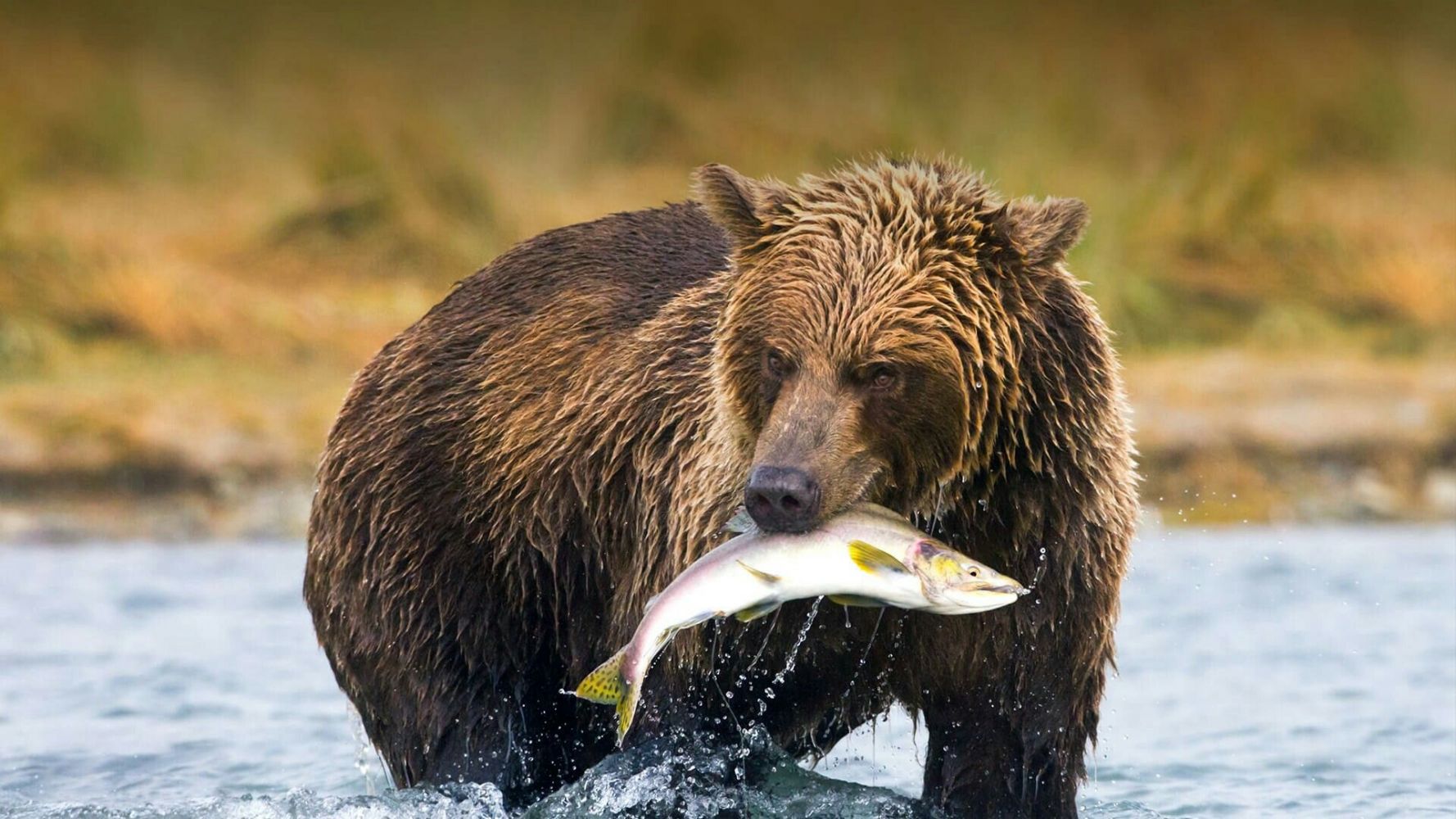The
Panamanian golden frog (
Atelopus zeteki) is a
species of
toad endemic to
Panama.
[3]
Panamanian golden frogs inhabit the streams along the mountainous
slopes of the Cordilleran cloud forests of west-central Panama.
[4] While the
IUCN lists it as
critically endangered,
[1] it may in fact have been
extinct in the wild since 2007.
[5][6] Individuals have been collected for
breeding in captivity in a bid to preserve the species. The alternative common name,
Zetek's golden frog, and the epithet
zeteki both commemorate the
entomologist James Zetek.
Description
Despite its common name, the Panamanian golden frog is a
true toad, a member of the family Bufonidae. It was
first described as a
subspecies of
Atelopus varius, but is now classified as a separate species.
[3][7][8]
The Panamanian golden frog is a national symbol and is considered to be one of the most beautiful frogs in Panama.
[9]
The skin colour ranges from light yellow-green to bright gold, with
some individuals exhibiting black spots on their backs and legs. Females
are generally larger than males; females typically range from 45 to
63 mm (1.8 to 2.5 in) in length and 4 to 15 g (0.14 to 0.53 oz) in
weight, with males between 35 and 48 millimetres (1.4 and 1.9 in) in
length and 3 and 12 grams (0.11 and 0.42 oz) in weight.
[10]
Toxicity
The Panamanian golden frog has a variety of toxins, including steroidal
bufadienolides and
guanidinium alkaloids of the
tetrodotoxin class. One of the latter,
zetekitoxin AB, has been found to be a blocker of
voltage-dependent sodium channels several orders of magnitude more potent than its analog
saxitoxin.
Their toxin is water-soluble and affects the nerve cells of anyone who
comes in contact with it. Panamanian golden frogs use this toxin to
protect themselves from most predators.
[9]
Due to the risk of testing the poison on humans, it has been done with
mice. Large doses can be fatal in 20 or 30 minutes. Death is preceded by
clonic (grand mal) convulsions until the functions of the circulatory and respiratory systems cease.
[11]
Distribution
The
Panamanian golden frog is endemic to Panama, living close to mountain
streams on the eastern side of the Tabasará mountain range in the
Coclé and
Panamá provinces.
[1] Its geographic range previously extended as far east as the town of
El Copé in western Coclé Province before the onset of the fungal disease
chytridiomycosis, which caused the El Copé population to rapidly collapse in 2004.
[1]
Vital habitat is lost each year to small farms, commercialized
agriculture, woodlot operations, livestock range, industrial expansion,
and real estate development.
[12] Individuals are kept in captive-breeding programmes in more than 50 institutions across North America and Panama.
[13][14]
Ecology
The lifespan of the Panamanian golden frog is 12 years.
[10]
This toad is unusual in that it communicates by a form of
semaphore, waving at rivals and prospective mates, in addition to the sounds more usual among frogs. This
adaptation is thought to have
evolved in the Panamanian golden frog because of the noise of the fast-moving streams which formed its natural habitat.
[6]
The male tends to stay near the streams where breeding occurs, while in
the nonbreeding season, the female retreats into the forests. The male
uses a soft call to entice prospective mates, then grabs the female and
hangs on when she crosses his path. If she is receptive, she will
tolerate
amplexus; if not, she will attempt to buck him off by arching her spine.
[citation needed] Amplexus can last from a few days to a few months, with
oviposition usually taking place in a shallow stream.
[5]
Life history
The development of
A. zeteki can be divided into four stages: larva or
tadpole,
juvenile, subadult, and adult. During the larval stage, individuals
emerge from their eggs after 2 to 10 days of development. They are
entirely aquatic creatures at this stage and are found in waters with a
temperature range from 20.4 to 21.3 °C and with depths of 5 to 35 cm.
After emerging, they mostly spend time resting in shallow pools below
cascades. This behavior is similar to
A. certus.
Wherever water pools in a stream, they are likely to be found, as long
as it is connected to moving channels. The tadpoles, however, do not
venture into the moving channels. Clinging to surfaces by suction of
their flattened bellies, the larvae can be characterized as
gastromyzophorous.
They are typically around 5.8 mm in length and 4.3 mm in width. Their
snouts are rounded, as well as their tails. The longest caudal fins on
their tails are about three-fifths the length of the tail. Their mouths
are large and ventral surrounded by labia which form an unbroken oral
disc about 3.6 mm wide. The posterior lip has no papillae, but other
lips are lined with single rows of small, blunt papillae. They are
colored from dark brown to black dorsally, with golden flecks on their
bodies. They develop this black and gold coloration as
melanin
floods their dermal layers, giving the larvae protection from the sun.
When metamorphosing, their golden flecks are replaced with dark green
ones.
[4] The tadpoles feed on algae and spend 6 to 7 months developing and growing.
[10]
The juveniles of this species are amphibious, but have a far
smaller range than subadults and adults. Normally, the juveniles are not
found more than 2 m from their streams, and recently metamorphosed
juveniles are more likely to be found next to the stream pools teeming
with tadpoles.
[4]
Like their adult counterparts, the juveniles go to higher elevations
and recede into trees to prevent predation; however, due to their small
size, the juveniles are not able to cover as much elevation and climb as
highly into trees and shrubbery.
[15]
At the onset of heavy and consistent rains, the juveniles flee from
the open streamsides, which are normally where the grown adult males,
which are very territorial, are known to roam. Territorial behaviors by
adult males could be initiated by these rains. Visually, the juvenile
has snout-to-vent lengths ranging from 8.4 to 17.1 mm. Their dorsal
coloration is a deep and vivid green which matches the color of the moss
that grows on the rocks in and around the streams of their habitat.
There are also dark brown to black dorsal markings. Some of the
juveniles are also known to have small dark markings on their digits.
Their abdomen is either white or goldenrod yellow, occasionally with
dark markings that do not match the ground color.
[4]
The subadults of this species have full ranges, but they are
sometimes found near adult males which is noteworthy because males of
this species are fairly solitary and combative in the presence of other
males. The subadult is about 28.3 mm long and weights about 1.1 g. They
are more greenish in color which more closely resembles the color of the
metamorphic juvenile than the brilliant and sometimes spotted golden
color of the adult. The patterning of subadults is significantly darker
than the adults.
[4]
Behavior
Panamanian golden frogs mating
The Panamanian golden frog appears to socialize with other amphibians
using sounds from the throat and hand-waving, like the semaphore motion
used in courtship. The movements may be friendly or aggressive
warnings.
[6]
It is an "earless" species of frog, meaning it lacks tympanum. This,
however, does not inhibit its ability to communicate with other members
of its species through throat sounds. Despite lacking eardrums, the
"earless" frog responds to vocalizations produced by members of its own
species. The male frog responds to a pulsed vocalization, characterized
by lower frequencies followed by higher frequencies, and so on, by
exhibiting antagonistic behaviors such as turning to face the source of
the sound and producing a pulsed vocalization in response. The pulsed
call is used to demonstrate male position during combative situations.
Like
Atelopus varius,
it is very territorial, living in the same site most of its life. As a
result of this site fidelity, it will not hesitate to vocalize when
another male frog encroaches on its territory. If this is not enough to
get the intruder away, the frog is not hesitant to defend its territory
through aggressive behavior.
[16] When encountering another male, male frogs will wave their forefeet as a sign of defense.
[9]
The Panamanian golden frog, apart from recognizing sounds, is
also able to locate the origin of a sound. This means it is capable of
directional hearing. In all other species of frogs, the role of the
eardrum is to pinpoint the direction of sound. Due to the very small
size of the Panamanian golden frog, it is difficult to imagine another
system of hearing that does not involve an eardrum apparatus.
[16]
When
A. zeteki encounters a predator, it often waves and
lifts its foot at the predator to call attention to its stunning and
beautiful coloring. This coloring is a warning of its toxicity, which is
enough to make a predator no longer consider the frog as a meal. If the
predator continues to approach, undeterred by the frog's warnings about
its toxicity, the foot waving, often accompanied with vocalizations,
will continue and increase in frequency and volume.
[16] Its toxicity is not a foolproof method of protection, since some animals, such as the
colubrid snake Liophis epinephalus,
are able to metabolize the frogs' poison. Ways to ward off predators
and prevent predation are different in their diurnal habits versus their
nocturnal ones, especially because the poison alone will not ward off
every predator. Adult males, which are active on the ground during the
day, recede into the trees and perch there at night. This is most likely
a defense mechanism. If the predator is approaching at night, the frog
cannot rely on a visual strategy for fleeing. They perch on trees
because it gives them the advantage of hearing approaching predators or
feeling their weight on the tree branch. The noise and tactile
advantages of climbing a tree are better than the advantages of
burrowing in the ground.
[15]
Conservation
The
Panamanian golden frog began vanishing from its high mountain forests
in the late 1990s, prompting a scientific investigation and rescue
process that continues today.
[17] It was filmed for the last time in the wild in 2006 by the BBC Natural History Unit for the series
Life in Cold Blood by
David Attenborough.
[6]
The remaining few specimens were taken into captivity and the location
of filming was kept secret to protect them from potential
poachers.
Although captive populations seem to thrive well, reintroducing them to
an area will not stop the threat of chytridiomycosis. No current
remedies prevent or control the disease in the wild, but efforts are
being made. One attempt was made to protect a wide variety of frogs from
the disease by using the bacterium
Janthinobacterium lividium
that produces a chemical against the infections; however, the skin of
Panamanian golden frogs was unsuitable for the bacterium used.
[18] The
San Diego Zoo
started a conservation effort and received their first frogs in 2003.
Since then, they have been able to successfully breed 500 individuals in
captivity but will not release them into the wild until the fungal
disease is less of a threat. The San Diego zoo also sends money to
Panama to keep up the conservation effort in the frogs' native country.
[10]
Populations of amphibians, including the Panamanian golden frog, suffered major declines possibly due to the fungal infection
chytridiomycosis. The infection is caused by an invasive fungal pathogen that reached El Valle, the home of the Panamanian golden frog, in 2006.
[19] Additional factors, such as habitat loss and pollution, may have also played a role.
[5]
The temperature at which these amphibians keep may be correlated
to chytridiomycosis; the fungus is more prevalent in colder conditions.
[20]
If a cold period occurs, the behavior and immunity of the frogs may
change around the same time more spores are released. When these frogs
are infected with the fungus, their body temperatures rise to fight off
the fungus. However, even if the infection leaves the frogs and body
temperatures return to previous normal levels, the infection can
re-emerge.
[21]
Another study found that dry conditions added an average 25 days to the
lifespan of infected individuals, while higher temperatures only added 4
days.
[22][23]
Not only do these frogs face the threat of the fungal disease,
but they also are threatened by human development. As trees are cleared
for housing and urbanization, the habitat of
A. zeteki is destroyed. Other threats include encroachment by agriculture, pollution, pet trade, and aquaculture.
[1]
Project Golden Frog is a conservation project involving
scientific, educational, and zoological institutions in the Republic of
Panama and the United States. The intended outcomes of this project
include greater understanding of the Panamanian golden frog, coordinated
conservation effort by governmental agencies and nongovernmental
organizations, heightened awareness of current global amphibian
declines, greater respect for wildlife among Panamanians and global
citizens, and greater land preservation for threatened and endangered
species throughout the world. This organization will use education and
field studies, producing offspring through the already captive toads,
and offering financial support to help preserve these toads.
[24]
Two significant efforts to save these frogs have been made. The
Amphibian Recovery Conservation Coalition, which started in 2004,
exported the endangered amphibians to the US, believing it was a better
environment for the endangered species. In 2005, the
Houston Zoo
established the El Valle Amphibian Conservation Center (EVACC) in
Panama, so the endangered frogs could have protected facilities in their
native country. EVACC has become a tourist attraction and the
populations of the housed species are watched closely by researchers.
[25]
In early 2006, EVACC exceeded its capacity for housing golden
frogs. In order to continue collection efforts, a partnership was formed
with the Hotel Campestre in El Valle whereby rooms 28 and 29 of the
resort were loaded with terrariums as a stop-gap measure.
[26] This was one of several conservation efforts covered in
Elizabeth Kolbert's
The Sixth Extinction: An Unnatural History.
[27]
Over 300 toads were kept in the so-called "golden frog hotel" and
treated to daily cleansing rinses, 24-hour room service, and exotic
lunches of specialty crickets until space could be made available in the
EVACC.
[28]
Experiment
Prior to the spread of the
Batrachochytrium dendrobatidis
fungus into Panamanian golden frog habitat, conservation organizations
collected Panamanian golden frogs and placed them in captive survival
assurance colonies. The skin of amphibians is host to a diverse resident
bacterial community, which acts as a defense mechanism in some
amphibians to inhibit pathogens. Researchers characterized the bacterial
community from wild and captive Panamanian golden frogs originating
from the same population with sequencing to assess how long-term
captivity has affected this community. Species richness, phylogenetic
diversity, and community structure of the skin microbiota were found to
be significantly different between wild and captive Panamanian golden
frogs. However, after approximately eight years of living in captivity,
the offspring of the original captive Panamanian golden frogs still
shared 70% of their microbial community with wild frogs. These results
demonstrate that host-associated microbial communities can be
significantly altered by captive management, but most of the community
composition can be preserved.
[29]
Reintroduction efforts from captive assurance colonies are
unlikely to be successful without the development of methods to control
chytridiomycosis in the wild.
[18] Researchers have experimented by using
Janthinobacterium lividium
to control the skin temperature in hopes the fungus would be kept at
bay. It seemed to be a protective treatment at the early stage, but the
frogs began to die after two weeks as the
Batrachochytrium dendrobatidis is the causative agent of chytridiomycosis.
[18]
Other methods of focusing on the phenotypic and genetic concordance to
do the conservation have been used. Researchers designated
A. varius and
A. zeteki
as separate species, but they are poorly sorted based on physical
characteristics, and better sorted based on mitochondrial DNA.
[8]
In culture
The Panamanian golden frog is something of a national symbol, appearing on state lottery tickets and in local
mythology. When the toad dies, it is thought to turn to gold and to bring good luck to those fortunate enough to see it.
[13]
In 2010, the Panamanian government passed legislation recognizing
August 14 as "National Golden Frog Day". The main celebration event is
marked annually by a parade in the streets of El Valle de Anton, and a
display of Panamanian golden frogs at the El Valle Amphibian
Conservation Center in the El Nispero Zoo, El Valle.
[30]
The highly toxic skin of the frog has also been used for centuries by
the native people of the Panamanian forests for arrow poison.
[11]



















